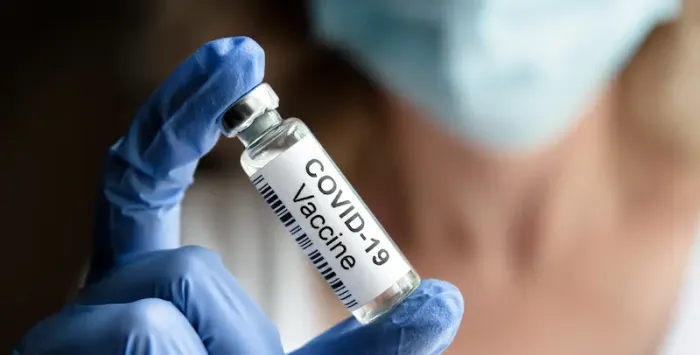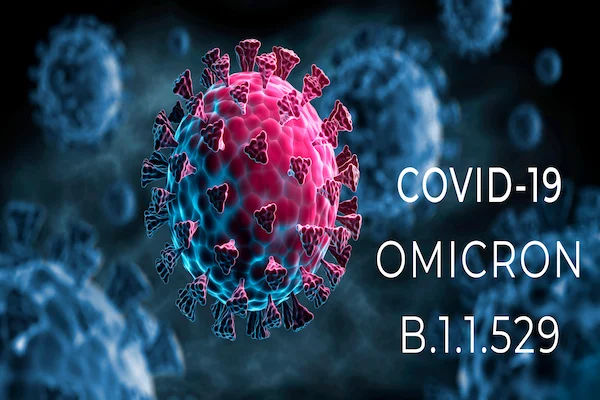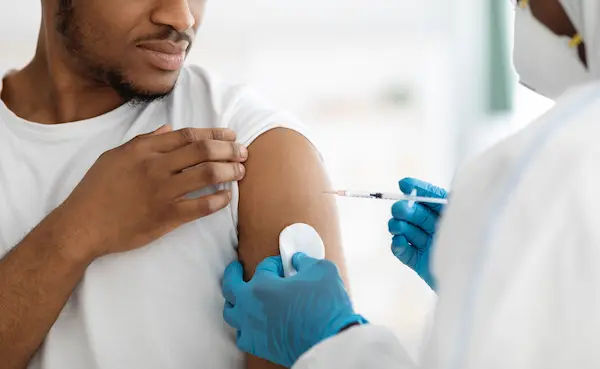Quick Guide to COVID Vaccination
Get the latest comprehensive information on COVID-19 vaccination, covering vaccine types, eligibility, safety, side effects, and the importance of boosters for community protection.

Written by Dr. J T Hema Pratima
Reviewed by Dr. D Bhanu Prakash MBBS, AFIH, Advanced certificate in critical care medicine, Fellowship in critical care medicine
Last updated on 22nd Oct, 2025

Introduction
COVID-19 hasn’t disappeared—it has evolved. Vaccination remains our best defense against severe illness, hospitalization, and long-term complications like long COVID. Whether you’re getting your first COVID shot, staying “up to date” with the updated 2024–2025 vaccine, or helping a family member decide, this category/covid vaccination guide brings you clear, practical answers. We explain how the new formulations target currently circulating variants, who should get vaccinated and when, what side effects to expect, and how vaccines protect people of different ages and health backgrounds. You’ll also find tips on getting your shot alongside flu or RSV vaccines, advice for pregnancy and children, and guidance on travel documents and proof of vaccination. Finally, we debunk the most persistent myths so you can make informed choices with confidence. If you need personalized advice, we’ll show you when to consult a clinician and how services like Apollo 24|7 can support you. Let’s get started with what COVID-19 vaccination is—and why it still matters in 2025.
What COVID-19 Vaccination Is—and Why It Still Matters
COVID-19 vaccination primes your immune system to recognize SARS-CoV-2, lowering your risk of severe disease, hospitalization, and death. Even as the virus shifts from pandemic surges to an endemic pattern, periodic waves continue—especially during colder months and in crowded indoor settings. Vaccination, particularly with updated formulations, aligns your immune response with the variants you’re most likely to encounter [1][2].
A common misconception is that vaccines “failed” because breakthrough infections occur. No vaccine offers 100% sterilizing immunity, especially against a rapidly evolving respiratory virus. The key metrics—prevention of severe illness and death—remain robust with current updated vaccines, especially in older adults and those with chronic conditions [2][3]. Several studies also suggest vaccination reduces the risk of long COVID, though not to zero, by lowering viral burden and dampening severe inflammation [1][2]. Real-world data show that countries with higher booster uptake see less pressure on hospitals during waves, preserving access to care for all conditions [4].
Unique insight: Think of vaccination like upgrading your device’s antivirus. Infection may still happen, but the “damage control” is far better with the latest database. That is the practical, ongoing value of category/covid vaccination.Consult a Top Gynaecologist
How COVID-19 Vaccines Work
Modern COVID-19 vaccines present your immune system with a blueprint for the virus’s spike protein. mRNA vaccines deliver instructions that your cells use briefly to produce a harmless spike fragment, stimulating antibodies and T cells. Protein subunit vaccines deliver the spike protein directly, often with an adjuvant to boost response [1][2].
• mRNA vaccines (updated 2024–2025 formulations): These remain the most widely used. Decades of research underlie the technology, and the mRNA is quickly broken down by your body. It does not enter the nucleus or alter DNA [2].
• Protein subunit vaccines: For those who can’t or prefer not to take mRNA vaccines, protein-based options provide an alternative approach with a familiar technology used in other vaccines.
Immunity basics: After vaccination, antibody levels peak and then decline, but immune memory (B cells and T cells) persists and can rapidly ramp up upon exposure. This memory response is what continues to protect against severe outcomes even as antibodies wane [1]. Long-tail terms naturally covered here include “hybrid immunity” and “COVID-19 vaccine effectiveness.”
2024–2025 Updates: Variants and Formulations
The 2024–2025 updated COVID-19 vaccines are designed against JN.1-lineage variants or closely related strains, chosen for their prevalence and immune-escape characteristics at the time of update [2]. The aim is to “retune” your immune system to match circulating viruses, much like seasonal influenza updates. Staying current with these updated 2024–2025 COVID-19 vaccine JN.1 formulations improves your chance of preventing severe disease during upcoming waves.
What does “up to date” mean in 2025? Public health guidance typically defines it as receiving one of the current season’s updated vaccines if eligible, with additional doses for some high-risk groups (details vary by country and age) [2][3]. If you had COVID recently, most authorities advise waiting about three months before a booster to optimize immune response, unless you are at very high risk [2]. This timing supports hybrid immunity—protection from both infection and vaccination—while minimizing side effects.
Unique insight: Consider aligning your COVID shot with your personal risk calendar. For example, get boosted a few weeks before travel, major gatherings, or winter season when indoor exposure rises.
Who Should Get Vaccinated (and When)
Everyone eligible is encouraged to stay up to date, with special emphasis on:
• Older adults (often 60 or 65+ depending on the country): higher risk of severe disease [2][3].
• People with chronic conditions (heart, lung, diabetes, kidney disease, obesity).
• Those who are immunocompromised or on immunosuppressive medications.
• Pregnant people: benefits include protecting both parents and newborn [1][3].
• Healthcare and essential workers with high exposure risk.
Children and teens: Most countries recommend updated doses for children, with dosing tailored to age. For some younger age groups, recommendations vary depending on the season and local epidemiology [2][3]. If you’re unsure, check your national guidance or speak to a clinician.
Timing: If you recently completed a vaccination series or had COVID-19, your next dose may be advised after about 3 months, or sooner in certain high-risk circumstances [2]. Long-tail terms covered: “COVID-19 booster schedule for adults” and “COVID booster for immunocompromised patients.” If your situation is complex (e.g., multiple comorbidities), consult a doctor; Apollo 24|7 can connect you with clinicians online to tailor timing to your needs.
Dosing and Schedules
• Primary series: People who’ve never been vaccinated may receive an age-appropriate primary series with the updated formulation. The number of doses can vary by product and age.
• Boosters: For most adults, a single updated 2024–2025 dose is advised for the season, with additional doses considered for older adults and immunocompromised people [2]. The exact interval since your last dose or infection may guide timing.
• After infection (hybrid immunity): Evidence suggests that spacing the next dose by about 3 months after infection can enhance the immune response while reducing reactogenicity [2]. However, those at high risk of severe disease may choose to vaccinate sooner after recovery—speak with a healthcare professional to personalize this.
• For immunocompromised individuals: Additional doses beyond the standard schedule may be recommended to achieve sufficient protection [2]. Examples include solid organ transplant recipients or patients receiving chemotherapy. Long-tail terms used: “COVID vaccine after infection, how long to wait” and “COVID booster for immunocompromised patients.”
Unique insight: Keep a simple “vaccine journal”: record dates of doses and infections. This personal timeline helps clinicians optimize your next dose and creates an easy reference for travel or work documentation.
Safety, Side Effects, and Rare Risks
Common side effects—sore arm, fatigue, headache, fever/chills—usually last 1–3 days. Over-the-counter pain relievers, hydration, and rest help. Most people are back to normal by day two or three [2][3].
Rare events: Myocarditis and pericarditis have been observed rarely after mRNA vaccines, more often in adolescent and young adult males, typically within a week after dosing. Most cases are mild and resolve with conservative care, but prompt evaluation is important if chest pain, shortness of breath, or palpitations occur [2][3]. The risk from COVID-19 infection itself exceeds the vaccine-associated risk.
Allergic reactions: Severe allergic reactions (anaphylaxis) are rare. Vaccination sites are equipped to manage them. If you have a history of severe allergy to a vaccine component (e.g., PEG), discuss an alternative vaccine formulation with your clinician [2].
When to seek help: If side effects last longer than 72 hours, symptoms are severe, or you have warning signs (chest pain, trouble breathing), seek medical care. If symptoms persist beyond two weeks, consult a doctor online with Apollo 24|7 for further evaluation.
Pregnancy, Breastfeeding, and Fertility
• Pregnancy: COVID-19 can be more serious in pregnancy; vaccination reduces risk of severe disease and adverse pregnancy outcomes [1][3]. Safety data from large registries have been reassuring. Vaccination during pregnancy also passes protective antibodies to the newborn, offering early-life protection.
• Breastfeeding: COVID-19 vaccination is safe while breastfeeding. Antibodies in breast milk may confer some passive protection to the infant [1][3].
• Fertility: Studies do not show that COVID-19 vaccines impair fertility in any gender. By contrast, severe COVID-19 illness and fever may temporarily affect sperm parameters—another reason prevention matters.
• Timing: Many choose to vaccinate in the second or third trimester, but it’s acceptable at any point in pregnancy. If you’re unsure, consult your obstetric provider. Long-tail terms addressed: “is COVID vaccine safe in pregnancy.”
Children and Teens
Benefits for younger age groups include protection against severe disease, MIS-C (multisystem inflammatory syndrome in children), and potential long COVID [2][3]. Doses and formulations vary by age; pediatric clinics follow updated schedules and provide child-sized doses with smaller needles.
Side effects: Similar to adults but often milder; brief fever or fatigue can occur. Myocarditis is very rare but monitored. Parents can prepare with hydration, comfort measures, and planning a lighter schedule the day after.
Practical tips:
• Bring a favorite toy or distraction for younger kids.
• Use numbing cream (if recommended by your provider) to reduce injection pain.
• Ask about coadministration with flu vaccine to minimize extra visits.
Older Adults and People with Chronic Conditions
Older adults face higher hospitalization and mortality risks from COVID-19, especially with comorbidities like heart disease, COPD, diabetes, chronic kidney disease, or obesity [2][3]. Vaccination remains one of the most effective interventions to prevent severe outcomes. For many older adults, an extra updated dose within the season may be advised to maintain protection.
Medication and timing: If you’re on immunosuppressants or have recent changes in your condition, discuss personalized timing. Consider scheduling vaccination before seasonal gatherings or travel to maximize protection. Long-tail terms used: “COVID-19 vaccine effectiveness among older adults” and “COVID vaccine and chronic conditions.”
Unique insight: Frame the booster as part of an “autumn respiratory bundle,” alongside flu and possibly RSV vaccines (if eligible), to consolidate protection heading into high-risk months.
Coadministration: Flu, RSV, and Other Vaccines
Coadministration: Many authorities allow COVID-19 and influenza vaccines on the same day, using different injection sites [2][3]. RSV vaccines (for eligible older adults or during pregnancy, per local guidance) can also be timed in the same season. Some individuals prefer spacing vaccines by a week or two to distinguish side effects; either path is reasonable.
Evidence suggests coadministration yields comparable immune responses and safety profiles, though mild side effects (like fatigue) may be slightly more frequent when multiple vaccines are given together [2]. If you have an important event the next day, consider spacing.
This section naturally incorporates “coadminister COVID and flu vaccine same day.”
Access, Cost, and Proof of Vaccination
• Where to get vaccinated: Pharmacies, primary care clinics, public health centers, and community pop-ups typically offer updated doses. Bring an ID and your vaccination card or app record.
• Cost: In many regions, COVID-19 vaccines remain free or covered by insurance; in others, a fee may apply. Check your local health department or clinic for details.
• Proof of vaccination: Keep physical and digital records. Some countries or events may still request evidence of recent vaccination. For international travel, check destination requirements well ahead of time. Long-tail terms covered: “COVID vaccination certificate for travel.”
Myths vs. Facts
• Myth: Vaccines change your DNA.
Fact: mRNA never enters the nucleus where DNA resides and degrades quickly [2].
• Myth: Vaccination causes infertility.
Fact: Data do not support this. Large studies show no impact on fertility [1][3].
• Myth: If vaccines “worked,” nobody would get infected.
Fact: Vaccines aim to prevent severe illness and death. Breakthroughs occur, but outcomes are far milder on average [2].
• Myth: Side effects are worse than COVID.
Fact: Most side effects are short-lived; the risks from COVID (including long COVID) are higher, especially in high-risk groups [1][2].
Community Impact and Long COVID
• Community benefits: Broad vaccine uptake reduces overall transmission, protects vulnerable people, and eases pressure on hospitals [4]. Even modest reductions in infection translate into significant system-level gains.
• Long COVID: Studies indicate vaccination lowers the risk of long COVID compared with being unvaccinated, likely by reducing the severity and duration of acute infection and shaping immune responses [1][2]. Risk isn’t zero, so layered measures (vaccination, ventilation, timely testing/treatment) remain wise during surges.
• Unique insight: Think “layers of safety” rather than a single silver bullet. Vaccination is the foundational layer that makes every other layer more effective.
Before and After Your Shot
Before:
• Sleep well, hydrate, and eat a light meal.
• Wear short sleeves and bring your vaccine card.
• If you’ve had a severe allergy to a vaccine component, discuss options first.
After:
• Expect a sore arm and possible fatigue or low-grade fever for 1–3 days.
• Use cold compresses, gentle arm movement, and consider acetaminophen/ibuprofen (unless contraindicated).
• Light activity is fine; listen to your body and rest as needed.
When to seek help:
• Symptoms lasting beyond 72 hours or severe chest pain, shortness of breath, or palpitations warrant medical care.
• If your condition does not improve after trying these methods, book a physical visit to a doctor with Apollo 24|7.
Special Clinical Contexts
• Immunosuppressants and cancer therapy: The immune response may be reduced. Additional doses or timing adjustments (e.g., vaccinating before chemotherapy cycles when possible) can help [2]. Transplant recipients may need tailored schedules.
• Allergies and contraindications: Severe allergy to a vaccine component is a contraindication to that product—alternative formulations may be available. A history of myocarditis after a prior dose requires a careful risk–benefit discussion.
• Deferment: Short-term deferral may be suggested if you are acutely ill with fever. After COVID infection, waiting about 3 months optimizes response unless you’re at high risk [2]. Long-tail terms used: “myocarditis risk after mRNA COVID vaccine” and “COVID vaccination for immunocompromised patients.”
The Road Ahead: Future of COVID-19 Vaccination
We are moving toward a seasonal model, similar to influenza. Expect periodic updates targeting predominant lineages (e.g., JN.1-lineage in 2024–2025) [2]. Researchers are also exploring broader, pan-sarbecovirus vaccines to future-proof immunity. Combination “respiratory season” strategies—COVID, flu, and RSV for eligible groups—could streamline protection and logistics.
Unique insight: Watch for nasal or mucosal vaccine candidates aiming to strengthen first-line defense in the airways. If successful, these could enhance protection against infection, not just severe disease.
When to Consult a Doctor and How Apollo 24|7 Helps
Consult a clinician if:
• You have persistent side effects beyond 72 hours.
• You’ve had myocarditis, pericarditis, or a severe allergic reaction before.
• You are immunocompromised or on complex therapies (e.g., transplant, chemotherapy) and need a tailored schedule.
• You’re pregnant and want individualized timing advice.
If symptoms persist beyond two weeks, consult a doctor online with Apollo 24|7 for further evaluation. While routine lab tests aren’t required for COVID vaccination, some complex cases may involve checking immune status or comorbidity control. Apollo 24|7 offers convenient home collection for tests like HbA1c (for diabetes management) or vitamin D where relevant to your overall health plan.
Consult a Top Gynaecologist
Conclusion
COVID-19 is here to stay, but serious illness doesn’t have to be. Staying current with category/covid vaccination—especially the updated 2024–2025 formulations—remains one of the most effective steps you can take to protect yourself, your family, and your community. Vaccines may not prevent every infection, but they consistently turn potential hospitalizations into manageable illnesses and reduce long COVID risk. If you’re older, have chronic conditions, are immunocompromised, or are pregnant, your need for updated protection is even greater. Consider aligning your booster with your personal risk calendar—before travel, major gatherings, or the winter season—and think of coadministering flu (and, if eligible, RSV) vaccines to simplify your schedule. Keep your records handy for work or travel, and use layered protection during surges. If you have questions about timing after infection, special medical circumstances, or lingering side effects, reach out to a healthcare professional. If symptoms persist beyond two weeks, consult a doctor online with Apollo 24|7 for further evaluation; and if needed, book a clinic visit through Apollo 24|7. With informed choices and up-to-date vaccination, we can navigate the endemic phase confidently—protecting what matters most.
Consult a Top Gynaecologist

Dr Bhawna Garg
Gynaecological Oncologist
26 Years • MBBS, MS, (PGI MS ROHTAK) FELLOWSHIP GYNECOLOGY ONCOLOGY, (CANCER INSTITUTE CHENNAI)
Delhi
Apollo Hospitals Indraprastha, Delhi

Dr. Vineet Mishra
Infertility Specialist
36 Years • MD, Phd, DSc
Ahmedabad
Apollo Hospitals - Gandhinagar, Ahmedabad, Ahmedabad

Dr Homeira Nishat
Obstetrician and Gynaecologist
34 Years • MBBS, Diploma in Obstetrics & Gynaecology
Bengaluru
Cure Hospital and Clinic, Bengaluru

Dr. Somdutta Basu
Obstetrician and Gynaecologist
7 Years • MBBS, MS Obstetrics & Gynaecology
Bansdroni
Siddhita Healthcare., Bansdroni

Dr. Saheli Kapat
Obstetrician and Gynaecologist
11 Years • MBBS, DNB Obstetrics & Gynaecology,FMAS(Fellowship in Minimal access surgery)
Kolkata
MCR SUPER SPECIALITY POLY CLINIC & PATHOLOGY, Kolkata
Consult a Top Gynaecologist

Dr Bhawna Garg
Gynaecological Oncologist
26 Years • MBBS, MS, (PGI MS ROHTAK) FELLOWSHIP GYNECOLOGY ONCOLOGY, (CANCER INSTITUTE CHENNAI)
Delhi
Apollo Hospitals Indraprastha, Delhi

Dr. Vineet Mishra
Infertility Specialist
36 Years • MD, Phd, DSc
Ahmedabad
Apollo Hospitals - Gandhinagar, Ahmedabad, Ahmedabad

Dr Homeira Nishat
Obstetrician and Gynaecologist
34 Years • MBBS, Diploma in Obstetrics & Gynaecology
Bengaluru
Cure Hospital and Clinic, Bengaluru

Dr. Somdutta Basu
Obstetrician and Gynaecologist
7 Years • MBBS, MS Obstetrics & Gynaecology
Bansdroni
Siddhita Healthcare., Bansdroni

Dr. Saheli Kapat
Obstetrician and Gynaecologist
11 Years • MBBS, DNB Obstetrics & Gynaecology,FMAS(Fellowship in Minimal access surgery)
Kolkata
MCR SUPER SPECIALITY POLY CLINIC & PATHOLOGY, Kolkata
More articles from Covid
Frequently Asked Questions
1) How long should I wait to get a COVID booster after having COVID?
Most guidance suggests about 3 months to optimize the immune response, unless you’re at high risk and need earlier protection. This supports hybrid immunity after vaccination and infection [2].
2) Can I get the COVID and flu vaccines on the same day?
Yes, coadministration is allowed and effective. Mild side effects may be slightly more common. It’s also fine to space them if you prefer [2][3].
3) Is the updated 2024–2025 COVID-19 vaccine safe in pregnancy?
Yes. Data show vaccination in pregnancy is safe and offers protection to both parent and baby. Timing can be individualized with your obstetric provider [1][3].
4) What are common COVID vaccine side effects and how long do they last?
Sore arms, fatigue, headache, and mild fever typically last 1–3 days. Hydration, rest, and OTC pain relievers help. If side effects last beyond 72 hours, seek medical advice [2].
5) Do I need extra doses if I’m immunocompromised?
Many immunocompromised people benefit from additional doses to achieve sufficient protection. Consult your clinician for a personalized COVID-19 booster schedule [2].




